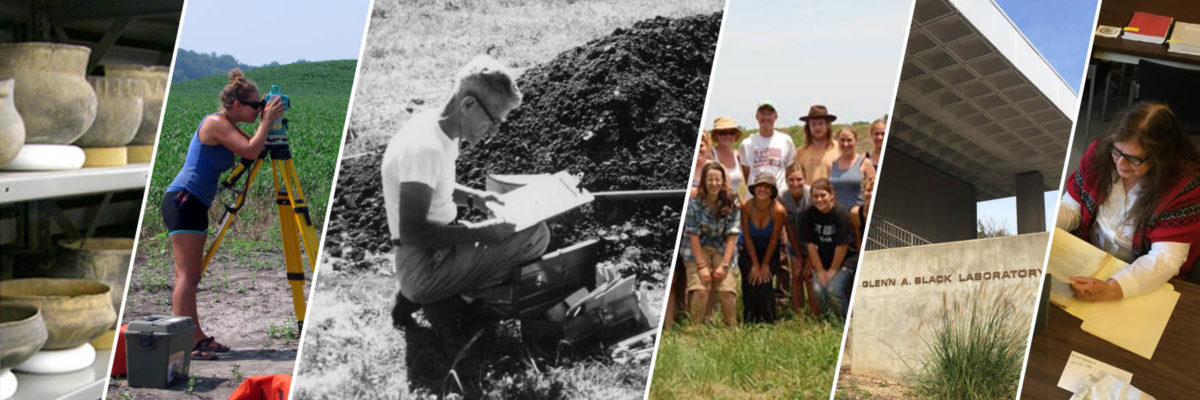In 1947, Glenn A. Black taught three courses in Indiana University’s Anthropology department. He did his best to teach excavation methods, problem-solving methods, and how to develop film and use the proper tools. But he found it wasn’t enough.
In Angel Site: An Archaeological, Historical, and Ethnological Study, published posthumously after his death in 1964, Black wrote he found it impossible to really teach students how to conduct fieldwork in the classroom. So he turned to field schools –after a few trial runs in 1945, ’46, and ’47, he received funding and the go ahead to establish a field school at the Angel Mounds Historic Site. The state of Indiana had held the title to the site since 1945; just a few years previously, it had been owned by the Indiana Historic Society.
It was in late 1947 at Angel that six old hutments from the U.S. Army were set up, along with (after some pushing) basic sanitation facilities, barracks, and a kitchen. Gertrude Behrick was hired as the cook. The first class of students arrived in June 1948.
This wasn’t the first excavation to take place at Angel Mounds in the twentieth century. During the Great Depression, jobs were provided at the site thanks to the Works Progress Administration. WPA efforts at the site lasted from 1939 to 1942, eventually halted by America’s entry into World War II.
By 1945, the war was winding down and Glenn Black and others were itching to return to the site.
Field schools weren’t exactly an easy sell to the University, and certainly weren’t just easy work for students looking to make a few bucks over the summer, something Black himself noted in Angel Site:
“Field schools can be justified only in the hope that the practical training given the students will pay dividends in the years which they devote later to field archaeology.”
Field schools continued (after the initial post-war test runs) from the first student group in 1948 to 1962, all at Angel Mounds with the exception of 1953 (which instead took place in Warrick County, at the Yankeetown site) and 1956.
In honor of Indiana Archaeology Month, here’s a few photographs of field school crews.
- 1949

Back Row: (left-right) Donald Lee Hochstrasser; Charles T. Jacobs; Hugh N. Davis, Jr.; William L. Kaschube; Richard W. Noel; Roy K. Flint; and a man identified only as Hickerson
Front Row: (left-right) Nancy Parrott Hickerson; Dorthea M. Vedral Kaschube; Barbara Jo Serber; Alice Shroyer; Ann Chowning; and Emily Jane Blasingham
Not Pictured: Henry P. Childs; Robert Crabtree; Ellas Adis-Castro; and Hilda J. Curry
- 1950

(left-right) Lynd J. Esch; Clarence H. Webb, Jr.; June S. Nettleship; Barbara J. MacCulley; Gerald W. Hubbart, Jr.; Jerry D. Hopkins; James H. Kellar; Robert C. Dailey; Jane Kellar; and Virginia E. Rice
Not Pictured: Hilda J. Curry and Hugh N. Davis, Jr.
- 1951

(left-right) James H. Kellar; John R. Longbons; Jana Kellar (baby); Ida Black (holding Jana); Jane Kellar; Emily Jane Blasingham; Gertrude Behrick; Robert Forth; Nelson Smith; Ann Liest; and Elizabeth Brockschlager
- 1954

(left-right) Lily O’C. J. Marchant; Joan Popoff; Bettye J. Broyles; and Ann Stofer Johnson
Not Pictured: Carol K. Rachlin
- 1955

Glenn A. Black (sitting, far right); George E. Noble; Ethel M. Enyart; Edward V. McMichael; and Martha Orr
Not Pictured: Richard Johnston, Joan Potochniak, and Lora Steele
- 1960

(left-right) Duane Campbell; Phyllis L. Jacobs; Jeaneatte Hornbaker; Loretta Reinhardt; John T. Dorwin; Andrew L. Szczesniak; and Robert C. Kiste
- 1962

(left-right) Richard B. Johnston; Theodore Stevens; William R. Merrimee; Charles Jenkins; and Charles A. Martijn
Not Pictured: Thomas Downen
Recently, there have been several other digs at Angel Mounds, and continued cooperation between the University, the GBL, and Angel Mounds to preserve and study the area’s history.
Sources:
Black, Glenn A. Angel Site: An Archaeological, Historical, and Ethnological Study. Indianapolis: Indiana Historical Society, 1967. Volume 1.


